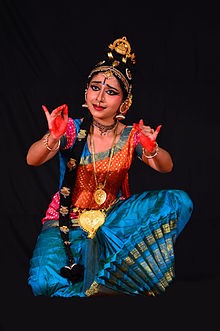Description

Disclaimer: Copyright infringement not intended.
Context
- Top of Form
- In Kuchipudi village, Krishna district, artists cherish memories of childhood performances in the 1980s. They recall dancing to songs sung by women, often their mothers, in their front yards.
Kuchipudi Dance History
- Ancient: The roots of Kuchipudi trace back to ancient times, influenced by the Natyashastra, a Sanskrit treatise on performing arts from the 2nd century BCE. Originating from the Bhagavathalu, itinerant actors, Kuchipudi was performed in villages, portraying stories from Hindu mythology.
- Medieval: In the medieval period, Kuchipudi experienced significant refinement under Siddhendra Yogi in the 15th century. Transforming from a folk art to a classical dance form, Siddhendra Yogi's contributions shaped Kuchipudi into a sophisticated expression of culture.
- Modern: In the modern era, the establishment of the Kuchipudi Art Academy in 1958 marked a milestone in preserving and promoting the dance form. Today, Kuchipudi stands as one of India's eight classical dance forms, blending tradition with contemporary influences, and captivating audiences worldwide.
Principles of Kuchipudi
The dance form is based on several key principles that are fundamental to its practice and performance. Here are some of the main principles of Kuchipudi:
- Tala and Layam: Kuchipudi is performed to the rhythm of a specific beat or tala, which is set by the accompanying musicians. The dancer must have a strong sense of timing and must be able to maintain the rhythm of the tala throughout the performance. The tempo or speed of the rhythm is also important, and the dancer must be able to adapt their movements to match the pace of the music.
- Abhinaya: Abhinaya is the art of expression through gestures and facial expressions. In Kuchipudi, the dancer must be able to convey emotions and tell stories through their movements and expressions. Abhinaya is a key element of the dance form and requires years of practice and training to master.
- Natya: Kuchipudi is not just a pure dance form but also involves storytelling through dance or Natya. The dancer must be able to portray characters from Hindu mythology and bring them to life through their movements and expressions. The stories are often accompanied by music and sung or spoken word, and the dancer must be able to synchronize their movements with the music and dialogue.
- Rasa: Rasa is the emotional flavour or essence of a performance. In Kuchipudi, the dancer must be able to convey the appropriate rasa or emotion for each scene or character. The eight Rasas or emotions are love, joy, anger, courage, sorrow, disgust, fear, and wonder.
- Lasya and Tandava: Kuchipudi involves a balance between two aspects of dance - Lasya and Tandava. Lasya is the graceful and fluid aspect of dance, while Tandava is the more energetic and dynamic aspect. The dancer must be able to blend these two aspects together to create a harmonious and balanced performance.
- Costume and Makeup: The costumes and makeup worn by Kuchipudi dancers are an integral part of the dance form. The costumes are usually brightly coloured and ornate and are designed to enhance the beauty and grace of the dance movements. The makeup is also important, with the dancer using facial makeup to highlight their expressions and emotions.
Kuchipudi Compositions
These compositions include both traditional pieces as well as newer works created by modern choreographers. Here are some of the main types of compositions in Kuchipudi:
- Varnam: Varnam is a complex and elaborate composition that is the centrepiece of a Kuchipudi performance. It combines elements of pure dance, storytelling, and expression, and is performed in two parts - the Sahitya or lyrical section, and the Swara or rhythmic section. Varnams are often based on themes from Hindu mythology, and require years of training and practice to master.
- Tillana: Tillana is a fast-paced and energetic composition that showcases the dancer's skill and agility. It is performed to a specific rhythmic pattern, and involves intricate footwork and quick movements of the hands and body. Tillanas are often accompanied by lively music and are a popular feature of Kuchipudi performances.
- Padam: Padam is a composition that focuses on expressing emotions through gestures and facial expressions. It is performed to a slow and melodious tune, and often tells a story or conveys a particular mood or emotion. Padams are an important part of the Kuchipudi repertoire and require a high level of skill and sensitivity to perform.
- Javali: Javali is a light-hearted and playful composition that is typically performed by female dancers. It combines elements of dance and music, and often features themes of love and romance. Javalis are known for their fast-paced footwork and lively movements, and are a popular feature of Kuchipudi performances.
- Sabdam: Sabdam is a composition that combines elements of pure dance and storytelling. It is usually performed to a catchy and rhythmic tune and often features themes of love and devotion. Sabdam are popular among audiences for their lively and entertaining nature.
- Keertana: Keertana is a devotional composition that is typically performed as a prayer or offering to a Hindu deity. It combines elements of dance and music, and often features repetitive chanting of the deity's name. Keertanas are an important part of the Kuchipudi repertoire and are often performed as a prelude to other compositions.
|
PRACTICE QUESTION
Q. Discuss the importance of preserving India's classical dances as cultural heritage. Evaluate challenges and initiatives in safeguarding these art forms.
|















